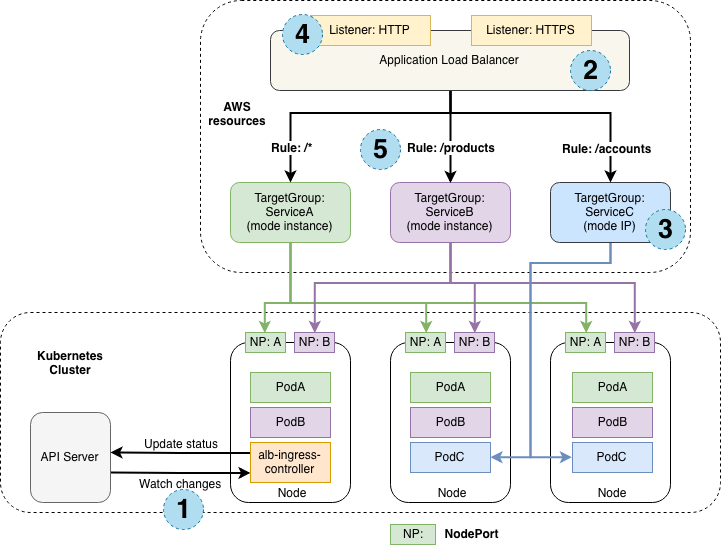IP mode
As mentioned previously, the NLB we have created is operating in "instance mode". Instance target mode supports pods running on AWS EC2 instances. In this mode, AWS NLB sends traffic to the instances and the kube-proxy on the individual worker nodes forward it to the pods through one or more worker nodes in the Kubernetes cluster.
The AWS Load Balancer Controller also supports creating NLBs operating in "IP mode". In this mode, the AWS NLB sends traffic directly to the Kubernetes pods behind the service, eliminating the need for an extra network hop through the worker nodes in the Kubernetes cluster. IP target mode supports pods running on both AWS EC2 instances and AWS Fargate.

There are several reasons why we might want to configure the NLB to operate in IP target mode:
- It creates a more efficient network path for inbound connections, bypassing
kube-proxyon the EC2 worker node - It removes the need to consider aspects such as
externalTrafficPolicyand the trade-offs of its various configuration options - An application is running on Fargate instead of EC2
Re-configuring the NLB
Let's reconfigure our NLB to use IP mode and look at the effect it has on the infrastructure.
This is the patch we'll be applying to re-configure the Service:
- Kustomize Patch
- Service/ui-nlb
- Diff
apiVersion: v1
kind: Service
metadata:
name: ui-nlb
annotations:
service.beta.kubernetes.io/aws-load-balancer-nlb-target-type: ip
namespace: ui
apiVersion: v1
kind: Service
metadata:
annotations:
service.beta.kubernetes.io/aws-load-balancer-nlb-target-type: ip
service.beta.kubernetes.io/aws-load-balancer-scheme: internet-facing
service.beta.kubernetes.io/aws-load-balancer-type: external
name: ui-nlb
namespace: ui
spec:
ports:
- name: http
port: 80
targetPort: 8080
selector:
app.kubernetes.io/component: service
app.kubernetes.io/instance: ui
app.kubernetes.io/name: ui
type: LoadBalancer
apiVersion: v1
kind: Service
metadata:
annotations:
- service.beta.kubernetes.io/aws-load-balancer-nlb-target-type: instance
+ service.beta.kubernetes.io/aws-load-balancer-nlb-target-type: ip
service.beta.kubernetes.io/aws-load-balancer-scheme: internet-facing
service.beta.kubernetes.io/aws-load-balancer-type: external
name: ui-nlb
namespace: ui
Apply the manifest with kustomize:
It will take a few minutes for the configuration of the load balancer to be updated. Run the following command to ensure the annotation is updated:
...
Annotations: service.beta.kubernetes.io/aws-load-balancer-nlb-target-type: ip
...
You should be able to access the application using the same URL as before, with the NLB now using IP mode to expose your application.
{"TargetHealthDescriptions": [
{ "Target": {"Id": "10.42.180.183",
"Port": 8080,
"AvailabilityZone": "us-west-2a"
},
"HealthCheckPort": "8080",
"TargetHealth": {"State": "initial",
"Reason": "Elb.RegistrationInProgress",
"Description": "Target registration is in progress"
}
}
]
}
Notice that we've gone from the 3 targets we observed in the previous section to just a single target. Why is that? Instead of registering the EC2 instances in our EKS cluster the load balancer controller is now registering individual Pods and sending traffic directly, taking advantage of the AWS VPC CNI and the fact that Pods each have a first-class VPC IP address.
Let's scale up the ui component to 3 replicas see what happens:
Now check the load balancer targets again:
{"TargetHealthDescriptions": [
{ "Target": {"Id": "10.42.180.181",
"Port": 8080,
"AvailabilityZone": "us-west-2c"
},
"HealthCheckPort": "8080",
"TargetHealth": {"State": "initial",
"Reason": "Elb.RegistrationInProgress",
"Description": "Target registration is in progress"
}
},
{ "Target": {"Id": "10.42.140.129",
"Port": 8080,
"AvailabilityZone": "us-west-2a"
},
"HealthCheckPort": "8080",
"TargetHealth": {"State": "healthy"
}
},
{ "Target": {"Id": "10.42.105.38",
"Port": 8080,
"AvailabilityZone": "us-west-2a"
},
"HealthCheckPort": "8080",
"TargetHealth": {"State": "initial",
"Reason": "Elb.RegistrationInProgress",
"Description": "Target registration is in progress"
}
}
]
}
As expected we now have 3 targets, matching the number of replicas in the ui Deployment.
If you want to wait to make sure the application still functions the same, run the following command. Otherwise you can proceed to the next module.